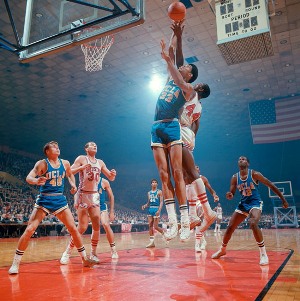| No. 9: Coming of Age
Texas is not a place that most people associate with the game of college basketball. That is something usually reserved for states like Indiana, Kansas, Kentucky or North Carolina. So it might be shocking to discover that two of the sport's most historically significant events have direct ties to a place where football is considered a form of religion.
The first of these is Texas Western's national championship in 1965-66. The Miners were the first to win it all with an all black starting five, and their success that season irrevocably changed the face of the game. This team's accomplishment had a cultural and societal impact that was felt far beyond the hardwood.
 |
|
Elvin Hayes hounded Lew Alcindor on the boards |
The other event was a single game which took place 42 years ago today (January 20, 1968) in Houston. While this game did not change the game of college basketball per se, it did have a tremendous impact on the business of college basketball. It is the game that literally put "March Madness" in your living room.
Dubbed "The Game of the Century" by many experts, this was the first regular season college basketball game to be broadcast nationwide. In addition to the millions of viewers, a crowd of 52,629 crammed into the Astrodome to watch the upstart Houston Cougars snap the UCLA Bruins 47 game winning streak 71-69 behind Elvin Hayes' 35 point performance.
Hayes was also the defensive star of the game, holding Lew Alcindor (a/k/a Kareem Abdul —Jabbar) to under 50% shooting from the field for the first, and only, time of his college career.
However, as great as the game was, that is only a small part what makes it special.
Up to that point, only NCAA post-season games were nationally broadcast, and only then by smaller broadcast companies who believed they could turn a quick profit. This game changed all that. It proved there were legions of college basketball fans across the country that would tune in and watch.
This game was the brainchild of Cougar coach Guy Lewis, and at first he seemed to be the only one who thought it was a good idea. The Cougars didn't have their own arena, playing their games in an off-campus gym that held only 5,500 people. During a visit to the Astrodome the previous spring, he came up with the idea of playing UCLA there.
Houston Athletic Director Harry Fouke rejected the idea at first. However, Lewis won Fouke over when he offered to pay both schools $10,000 out of his own pocket.
"Harry knew I couldn't raise $10,000," Lewis has been quoted as saying. "I probably couldn't have raised $500, but he said, 'If you believe in it that much let's talk about it.' "
Fouke called UCLA Athletic Director J.D. Morgan who proposed the idea to UCLA Head Coach John Wooden.
"I thought at the time that it was professionalizing the college game, and I didn't approve of that," Wooden recalls.
However, Morgan thought the game would be good for college basketball and wanted UCLA to be a part of it. He overruled Wooden's objections and agreed to the game.
Now that both teams had agreed, there was still another hurdle — getting permission from Houston Astros owner Judge Roy Hofheinz to hold the game at the Astrodome.
Initially, Hofheinz was not keen on the idea. The arena had been designed for baseball and football, it wasn't meant for basketball.
Lewis still laughs about the exchange.
"But you have this little ball in baseball," Lewis argued. "Don't you think people could see our big one? And besides, most of the players on my team are bigger than the ones on your baseball team."
"Well, damn if you're not right," Hofheinz said, laughing.
The game faced one final obstacle — televising it. All three of the major networks initially passed on the idea, although ABC later offered to put it on the Wide World of Sports. Up to the plate stepped Eddie Einhorn and his TVS Network, paying $27,000 for the television rights
Einhorn traveled the country and called upon station after station. He was selling a novelty - a college basketball game broadcast nationally in prime time. The going was slow, but in the end, 120 stations signed up, canceling their regular programming to air the game.
The teams did their part by continuing to win. UCLA, the defending national champion, came into the game as the country's top-ranked team. The Cougars were right behind them at number two.
As they entered the arena, both teams were stunned by the size and the noise of the crowd of more than 52,000 people, the most ever to see a basketball game in the United States at that time. "Slow down," Lewis told his players. "I want to enjoy this."
Two hours and a two point victory over the premier team in college basketball later, Lewis was still enjoying himself.
Forty-two years later, sports fans across the country are still reaping the benefits of this game. Contests like this are now commonplace, and college basketball rules the airwaves in the month of March.
In 1969, NBC became the first major network to broadcast the championship game, at a cost of more than $500,000. In 2010, the current NCAA deal with CBS to televise the entire tournament is worth 1,200 times that amount.
As it turns out, this was a bittersweet moment for Houston. Three months later these same teams faced each other in the Final Four. The Bruins got their revenge by pounding the Cougars 101-69. And that game drew even higher ratings than the first contest.
So in a couple months, when you call in sick to work to watch the first round of "The Dance", utter a few words of thanks to Guy V. Lewis. It was his simple yet grandiose idea that proved what a viable media commodity college basketball truly is.
|